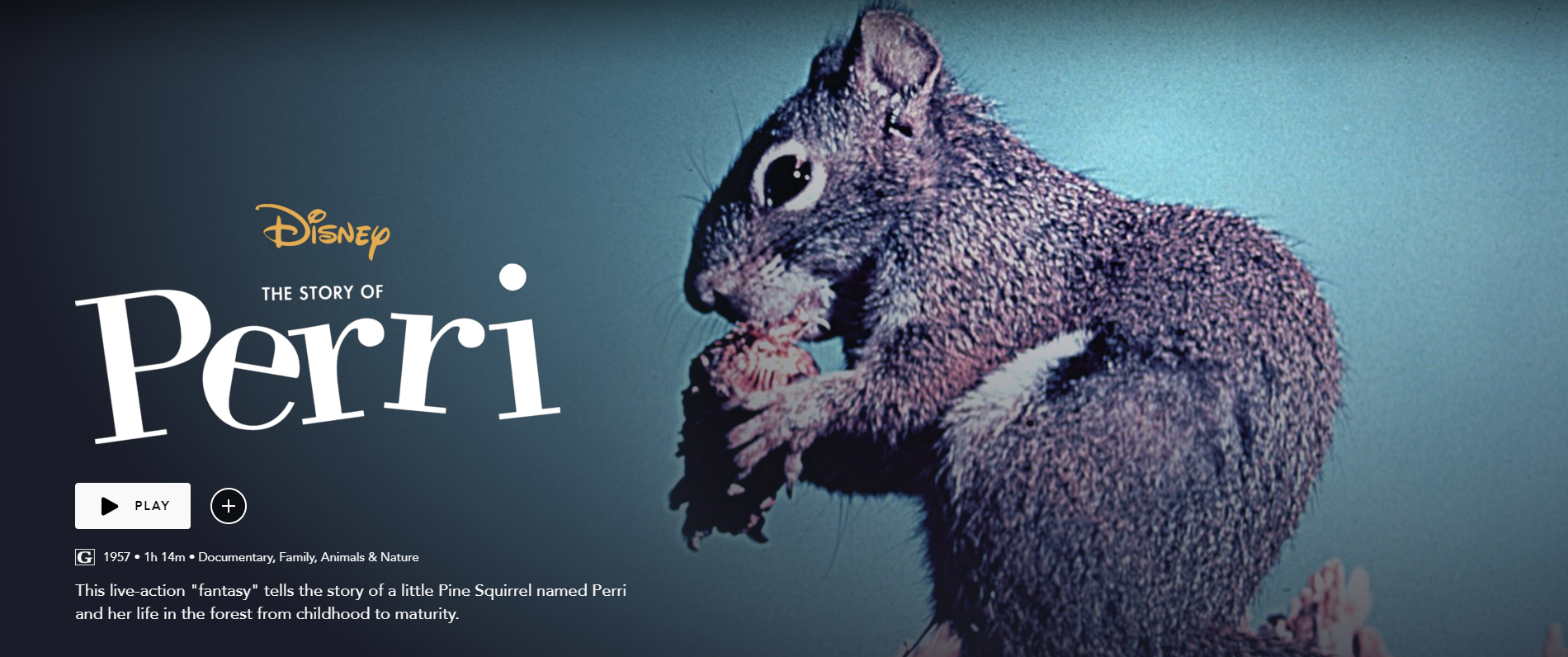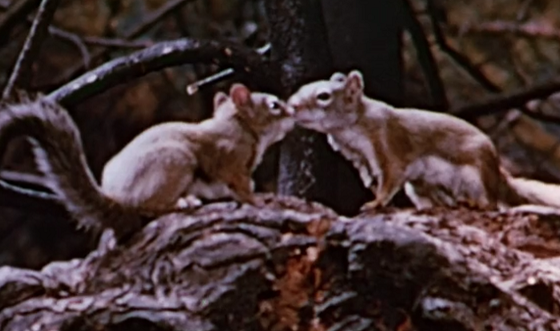Review: Perri (DMC #25)
Hello and welcome back! This week we watched Perri, the 25th movie in our Disnerd Movie Challenge. This is the first of the True Life Adventures films to be dubbed a “True Life Fantasy.” As always, check out our synopsis if you didn’t watch along last night, otherwise scroll down for our review.
Synopsis
In the forest of Wildwood Heart, we meet a baby squirrel named Perri. Not long after her birth, Perri’s family is attacked by a marten. When the marten attacks Perri’s mother, her father lures the marten away from the nest, only to be killed by the marten. Perri’s mother hurriedly relocates the family to a new nest where they are safe from the marten—for now. As Perri grows up she learns how to climb trees while the other young animals learn their own survival skills. One day, Perri tries to fly like a flying squirrel and ends up landing in a new, unfamiliar part of the forest. By the time she makes it home, she discovers her nest has been destroyed and her family is nowhere to be found. A marten lies in wait, then tries to attack Perri. Perri narrowly escapes the marten by swimming across the river, only to encounter a bobcat. A neighboring squirrel named Porro sees Perri being chased by the bobcat, and he lures the bobcat up a skimpy tree so that he and Perri can get away.
While Porro continues building his nest in a tree, Perri finds her own home in an abandoned hole in a neighboring tree. Though the marten tries to cross the river, it fails. While gathering food for winter, Perri is attacked by a hawk and falls from the treetops to land in the creepy Grove of Crooked Aspen where she’s attacked by a weasel and then a hawk. In a final scuffle, the hawk catches the weasel and Perri escapes. Back in their part of the forest, Porro is blown from his treetop nest by strong winds and is forced to shelter in an abandoned burrow for the winter while Perri shelters in her tree. As winter sets in, the marten again tries to cross the river and fails. When spring arrives, Porro invites Perri with a mating call, but their courtship is interrupted by a lightning strike that sets fire to the forest. Perri first tries to shelter in her tree, but Porro warns her of the flames and runs to shelter in his winter burrow. Perri escapes her tree and shelters with other animals at the beaver dam. After the fire, Perri and Porro return to look for each other, but the marten now has found a bridge to cross the river. The marten tries to get Perri, but Porro draws the marten away. Unfortunately this also attracts the attention of a nearby bobcat. There’s a scuffle between all three. The bobcat ultimately kills the marten and Porro is safely reunited with Perri.
Thoughts Before Watching
Kevin: I read a little about this film ahead of us actually watching it, and in doing so I found myself cautiously optimistic. I’ll expand more on this later, but apart from that little bit of background knowledge I figured this just had to be better than Secrets of Life!
Megan: Having seen one too many nature documentaries from this era, I’m not getting my hopes up on this one. It does seem to be about a single squirrel, though, so perhaps this one will have a bit more plot and character development to keep us entertained?
Thoughts After Watching
Documentary meets fantasy = pretty good?
Kevin: Well, maybe saying “pretty good” is too generous, because I can’t really justify giving this a high score, but this was better than I expected it to be. I read that Disney realized that the previous True Life films were becoming stale and formulaic, so the company wanted to try something new. To them, it sounded like a good idea to stay the course with this nature documentary, but apply the Disney storytelling formula. This story was written by Felix Salten, who also penned the novel Bambi, a Life in the Woods, and Walt looked to Perri as just the right material to test his new endeavor. The result was worth it. Most of the time the movie is still dull in many areas; the story isn’t that particularly exciting and the pacing is slow. On the other hand, the now-classic Disney storytelling elements add a small bit of excitement. The movie departs from the others in the series right from the way it opens, which looks and sounds more like one of Disney’s animated films. There’s a good sense of humor throughout the movie, and there’s even a soundtrack that almost rivals those of the studio’s early work. I thought the dream sequence was interesting and very similar to the “Pink Elephants” sequence from Dumbo, and this is just one of the many similarities this movie has to other Disney movies.
Disney fantasy tropes can’t save this film.
Megan: I have to disagree with Kevin here—the added fantasy elements might earn this documentary an extra point in ratings, but it’s not enough to save it in my opinion. Sure, they abide by the typical formula that worked for their previous animated films with a “once upon a time” style of storytelling (and in true Disney fashion, the protagonist’s parent dies), but it’s hard to pull together documentary footage of observed animals into a fictional story structure. Thus, Perri has very little character development, the marten is only a loose antagonist, and the plot drags at several points (case in point—that dream sequence. What even was that?). Also, I know Kevin appreciated the songs (more on that below), but for me those were some of the most boring parts of the film. The old style and the lack of visual interest made it hard to sit through those.
Nature isn’t always pretty.
Kevin: We’ve already seen this theme in the last several documentaries, but somehow it was even more noticeable, at least for me. Perri is structured like a play, something the narrator admits, and the very story we’re given allows the viewer to root for Perri (and, later, Porro) as our main character while the marten could arguably be called the villain. The way this movie plays out it can be easy to invest in what’s going on with the characters. And so, when the marten fails to catch Porro, only for it to become prey to the wildcat, the moment feels all too like the death of any other Disney villain. But then, we must remember that this is just simply nature taking its course. I didn’t exactly root against the marten because it’s silly to be for or against a wild animal just simply doing what it needs to do for survival. There’s really no good or bad actions taken by any of the animals. Still, both Megan and I were instantly hoping the marten would fail in its quest to eat Perri. Yet when the tables are turned on the marten as a raccoon almost kills the baby martens, we were rooting for the baby martens to be okay. Maybe it’s because we see them as more innocent, even though in nature there really is no innocent party. I guess a small part of me hoped that no animal would die here including the marten because it’s difficult to watch sometimes. Disney played this movie off like it was a real-life story, and so Perri and Porro’s happy ending might be hard earned and won, but it’s really just another day before they are hunted by predators again.
“Abandon all emotion”?
Megan: While I get that nature isn’t always pretty, and that carnivores need to eat just as herbivores do, I took issue with the narrator telling the audience that if we’re to watch this we must “abandon all emotion, all distress” because death is a natural part of nature. This is especially troubling if we think of children being given this message. While I think it’s important for children to learn about death, I don’t ever want them to abandon their emotions. I think especially in today’s world we’re realizing how hard society makes it for us to be the emotional humans that we naturally are. We’re constantly told how undesirable certain emotions are, and yet those of us who are more in tune with our emotions and allow ourselves to feel every emotion freely tend to have better mental health. I think perhaps the intent of the narrator was to warn that not all would end happily for the animals in this film, but the choice to say “abandon all emotion” is very telling of the sentiments of the 1950s compared to today.
Also telling of the 1950s are the subtle language choices that betray a sexist point of view. I’ve touched on this a number of times with the previous films, so I won’t get into it much here. Suffice it to say that even with a female protagonist this still fails the Bechdel test.
The music is one of the highlights.
Kevin: I think the filmmakers did a wonderful job on the music here. Some of the songs are familiar to anyone who has watched all of the previous films in the challenge. “Now to Sleep” recalls “Baby Mine” from Dumbo, as both are soft lullabies (but perhaps the song in Perri is less sad). “Together Time” harkens back to both the “twitterpated” scene and the tune “Let’s Sing a Gay Little Spring Song” from Bambi. I can’t say that the songs in Perri are as catchy as those in other movies, but then again it may just need to grow on me. Either way, I appreciate that the studio decided to create and include these in here. It drives home the storytelling feel Disney was going for.


